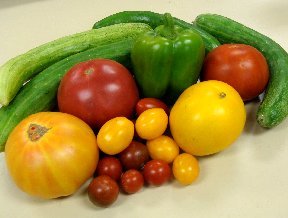Almost
any vessel can be used as a container, but it must have drainage holes that
allow water to freely flow through the pot. Most veggies only need 8” of soil
depth. Trays and smaller containers work fine for lettuce, radishes, spinach,
and peppers. Root crops like carrots and onions, and large plants like most
tomatoes and squash, require containers larger than 16 inches in diameter.
Generally as a rule, bigger is better for root growth and overall vigor.
When
growing veggies in containers, packaged potting mixes are typically the best
choice to use for a planting medium. Using garden soil in containers is never
ideal. Packaged potting mixes are lightweight, moisture retentive, and well
aerated. In addition, they do not harbor any fungi, bacteria, insects, or weed
seeds that would cause problems later.
Sunlight,
not space, is probably the biggest limiting factor in urban environments.
Without at least six hours of sun a day, it will be tough to grow quality
vegetables. Crops need a lot of solar energy to make nutritious fruits, seeds,
and leaves. Southern exposure is best, but six hours from any direction should
be sufficient. To avoid leaning or uneven ground, rotate the containers weekly.
Use wire cages or other sturdy supports to protect large plants like tomatoes,
beans, peas, and squash.
Regular
watering is crucial when you grow in containers because there is a limited soil
mass for storing water. During the peak of summer heat, gardeners may need to
water daily to keep plants growing at full potential. A drip irrigation system
allows you to water automatically, and with a timer, you can even water
containers while you’re away. However, the best option for vacation watering is
always a reliable neighbor. Vegetables grown in containers also need regular
fertilizing. Follow the label
instructions, and make sure the container is well drained or plants may suffer
from high salt levels due to fertilizer buildup. Some gardeners combine the two
tasks and simply water with a quarter-length fertilizer solution once a week.
If
plants don’t appear vigorous and healthy, check them closely because disease
and pest infestations can quickly get out of hand. If caught early, most are
easy to treat. Check the undersides of leaves for insects. Many of them can be
picked off or sprayed with a strong stream of water. Some pests require other
treatments. Natural insecticides are very popular with home gardeners. Always
read insecticide labels to make sure the product is compatible with food crops,
and follow the directions carefully.
When
looking for plants, look for vigorous young seedlings with bushy growth. Check
to make sure each seedling is securely anchored in the six-pack or pot, which
implies a well-established root system. Dip the seedling in a bucket of water
to moisten the root ball, tease out any circling roots, and plant it at the
same depth it was previously growing. (Tomatoes are an exception to the
planting depth rule because they can be planted with the bare stem several
inches below the ground, and roots will form along the stem.)
Some
crops like lettuce, beets, and carrots, are best grown from seed. Simply follow
the instructions on the packet. Be sure
to thin sprouts to the recommended spacing. Thinning is a ruthless task, but
fortunately most veggie sprouts can be used in salads and other dishes for a
spring treat.
If
you have space to do a small raised bed garden in place of containers, check
out www.squarefootgardening.com for a complete listing and schedule
to produce a plentiful harvest for a family of four. Dig in and see how great
and beneficial veggie gardening is!
Enjoy the season,
Sandi Hillermann McDonald

